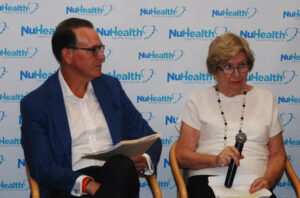By Julianna Iovino
Long Island is widely known for producing some of the biggest musicians ever, such as Billy Joel and Mariah Carey. For alternative music and its subcultures — punk, alternative rock and emo — the Island has for decades served as a hub for artists of this genre.
According to Long Island Music Magazine, some of the best-selling albums to come out of the Island were by alternative artists. Big-name groups like Taking Back Sunday emerged from the late 1990s and early 2000s alternative scene, garnering fans across the world, and lesser-known artists like The Movielife enjoyed close followings and staged many shows during this time.
Now many say Long Island is experiencing an alternative music renaissance. A new generation of bands and local listeners in the post-Covid era has brought back the love and support for alternative music, especially the punk and alternative rock subgenres, that the Island was once well known for.
Gina Zazzi, a volunteer at the Long Island Music and Entertainment Hall of Fame and a long-time fan of alternative music, described the Long Island scene as thriving. Sometimes heavy music, such as metal and hardcore, is more popular, she said, while at other times emo, known for its emotional expression, dominates.
Zazzi explained how in the 1990s, heavy music artists like Mind Over Matter and Kill Your Idols were popular, but by 2002-03, more melodic artists like Taking Back Sunday and Head Automatica became more sought after. By the 2010s, the cycle came back around with more heavy artists, and now, after the coronavirus pandemic, more melodic artists have taken the stage.
Zazzi is not the only one who believes in the current thriving state of the alternative music scene. Lead singer and rhythm guitarist of the Long Island alternative punk rock band The Knottie Boys, Daniel “Dan” Fulciniti, said he too had noticed a resurgence in audiences.
Fulciniti, who has performed at local venues since 2018, when he was 18, said 2023 has been his best year ever. The biggest problem, however, Fulciniti added, was there were traditionally no places that welcomed young people — most were 21-plus.
“I would get crap for being younger than 21,” Fulciniti said, while describing the situation back when he first started playing. That “made it hard to go to shows and play shows.” He also explained how older listeners at shows were not as supportive and did not spread the word about artists whom they enjoyed as much as the current younger generation does.
Fulciniti credits the uptick of younger people on the alternative scene to a newly opened venue called The Cave in Medford, a hamlet in the Town of Brookhaven in Suffolk County,
“The guy who runs it… really wants to help people out,” Fulciniti remarked. He told of how after The Cave opened, he saw more young people attending shows as regulars, buying more merchandise and listening to local groups.
“I can say right now with 100% certainty that the scene is very much thriving,” said the owner of The Cave, who answered questions via Instagram and requested that he be referred to only as “The Caveman.”
“It’s a very live community that has had very few places to go, especially considering the age of some of the fans. Most bars won’t allow anyone under 18,” The Caveman wrote.
The Cave has no age policy and does not serve drinks. The owner explained that the venue has a group of regulars who are ages 15 to 17. “These people had nowhere to go before,” The Caveman said. Hardcore and punk never died. It just had nowhere to go.
There are differences between today’s alternative scene and that of 20 years ago. “Younger people are not as much into the business end of a band,” said Rich Branciforte, publisher of Good Times Magazine and a Long Island Music and Entertainment Hall of Fame board member.
At the same time, social media, often thought of a boon to artists, is not always a help, Branciforte said, explaining that social media followers do not always translate to concert attendees. Bands often book venues hoping to sell out because of their thousands of followers, he said, but few fans attend. Too often, he said, young artists focus more on building social media followings rather than live audiences.
Still, Branciforte believes the alternative scene is thriving. He also thinks music schools, such as School of Rock on Long Island, have aided in helping young musicians form bands.
All agreed that artists need ongoing support. “If you like them, see what they do,” Fulciniti said. “Buy a shirt… see their designs.”









